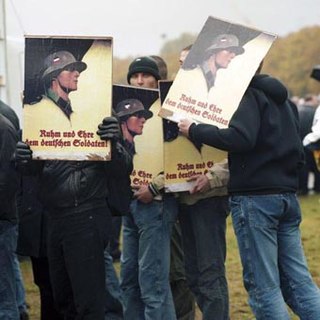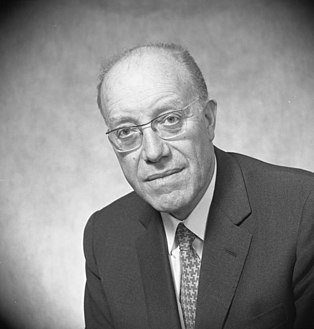Related Research Articles

The Wannsee Conference was a meeting of senior government officials of Nazi Germany and Schutzstaffel (SS) leaders, held in the Berlin suburb of Wannsee on 20 January 1942. The purpose of the conference, called by the director of the Reich Main Security Office SS-Obergruppenführer Reinhard Heydrich, was to ensure the co-operation of administrative leaders of various government departments in the implementation of the Final solution to the Jewish question, whereby most of the Jews of German-occupied Europe would be deported to occupied Poland and murdered. Conference participants included representatives from several government ministries, including state secretaries from the Foreign Office, the justice, interior, and state ministries, and representatives from the SS. In the course of the meeting, Heydrich outlined how European Jews would be rounded up and sent to extermination camps in the General Government, where they would be killed.

Steglitz-Zehlendorf is the sixth borough of Berlin, formed in Berlin's 2001 administrative reform by merging the former boroughs of Steglitz and Zehlendorf.

Wannsee is a locality in the southwestern Berlin borough of Steglitz-Zehlendorf, Germany. It is the westernmost locality of Berlin. In the quarter there are two lakes, the larger Großer Wannsee and the Kleiner Wannsee, are located on the River Havel and are separated only by the Wannsee Bridge. The larger of the two lakes covers an area of 2.7 km2 (1.0 sq mi) and has a maximum depth of 9 m (30 ft)

The Federal Intelligence Service is the foreign intelligence agency of Germany, directly subordinated to the Chancellor's Office. The BND headquarters is located in central Berlin and is the world's largest intelligence headquarters. The BND has 300 locations in Germany and foreign countries. In 2016, it employed around 6,500 people, 10% of them Bundeswehr soldiers, who are employed by Amt für Militärkunde.
Nikolaj Vladimirovich Timofeev-Resovskij was a Soviet biologist. He conducted research in radiation genetics, experimental population genetics, and microevolution. His work was of special importance to Soviet biology because it stood in direct opposition to the damage done by Lysenkoism, while his life was highlighted by scientific achievements in the face of severe personal hardship.
Hede Massing, née "Hedwig Tune", was an Austrian actress in Vienna and Berlin, communist, and Soviet intelligence operative in Europe and the United States during the 1930s and 1940s. After World War II, she defected from the Soviet underground. She came to prominence by testifying in the second case of Alger Hiss in 1949; later, she published accounts about the underground.

Berlin-Wannsee station is a railway station opened in 1874 which lies in the Wannsee district of Berlin, the capital city of Germany. It is an important traffic junction in south-west Berlin that is served by the RegionalExpress and RegionalBahn trains of the Deutsche Bahn, the Harz-Berlin-Express of Veolia Verkehr and by the Berlin S-Bahn. In summer, Wannsee serves as the Berlin terminal for DB AutoZug car carrying trains to and from southern Europe.

The Wehrmachtsausstellung was a series of two exhibitions focusing on the war crimes of the Wehrmacht during World War II. The exhibitions were instrumental in furthering the understanding of the myth of the clean Wehrmacht in Germany. Both exhibitions were produced by the Hamburg Institute for Social Research ; the first under the title "War of Annihilation. Crimes of the Wehrmacht 1941 to 1944", which opened in Hamburg on 5 March 1995 and travelled to 33 German and Austrian cities. It was attended by 800,000 visitors claimed the organizers. The second exhibition – which was first shown in Berlin in November 2001 – attempted to dissipate considerable controversy generated by the first exhibition according to the Institute.

The Soviet Alsos or the Russian Alsos was an operation that took place during 1945–1946 in Germany, Austria, and Czechoslovakia, and whose objectives were the exploitation of German atomic related facilities, intellectual materials, material resources, and scientific personnel for the benefit of the Soviet atomic bomb project.
Rudolf Heinz Pose was a German nuclear physicist.
Nicholas N. Poppe was an important Russian linguist.
Justus Mühlenpfordt was a German nuclear physicist. He received his doctorate from the Technische Hochschule Carolo-Wilhelmina zu Braunschweig, in 1936. He then worked in Gustav Hertz's laboratory at Siemens. In 1945, he was sent to Institute G, near Sukhumi and under the directorship of Hertz, to work on the Soviet atomic bomb project. Released from Russia, Mühlenpfordt arrived in East Germany in 1955. He was appointed director of the Institut für physikalische Stofftrennung of the Academy of Sciences, in Leipzig. From 1969 until his retirement in 1974, Mühlenpfordt was director of the Forschungsbereiches Kern- und Istopentechnik der Akademie.

Werner Hartmann was a German physicist who introduced microelectronics into East Germany. He studied physics at the Technische Hochschule Berlin and worked at Siemens before joining Fernseh GmbH. At the end of World War II, he and his research staff were flown to the Soviet Union to work on their atomic bomb project; he was assigned to Institute G. In 1955, he arrived in the German Democratic Republic (GDR); in the same year, he founded and became the director of the VEB Vakutronik Dresden, later VEB RFT Meßelektronik Dresden. In 1956, he completed his Habilitation at the Technische Hochschule Dresden and also became a professor for Kernphysikalische Elektronik there. In 1961, he founded the Arbeitsstelle für Molekularelektronik Dresden (AME). He was awarded the National Prize of GDR in 1958. In 1974, he was removed from his positions, significantly demoted, and sent to work as a staff scientist at the VEB Spurenmetalle Freiberg. Hartmann had been the object of security investigations by the Stasi for some time; while he was investigated at length and repeatedly interrogated, the alleged charges were politically motivated and no trial ever took place. The Werner-Hartmann-Preis für Chipdesign is an industrial award given in Hartmann's honor for achievement in the field of semiconductors.
Michael Achmeteli (1895–1963) was a Georgian émigré scholar, an expert on Soviet agriculture and sometime chief of Wannsee Institut, the SS-controlled research institute of Soviet studies in Nazi Germany.
Josef Schintlmeister was an Austrian-German nuclear physicist and alpinist from Radstadt. During World War II, he worked on the German nuclear energy project, also known as the Uranium Club. After World War II, he was sent Russia to work on the Soviet atomic bomb project. After he returned to Vienna, he took positions in East Germany. He was a professor of physics at the Technische Hochschule Dresden as well holding a leading scientific position at the Rossendorf Central Institute for Nuclear Research.

Helmholtz-Zentrum Berlin für Materialien und Energie is part of the Helmholtz Association of German Research Centres. The institute studies the structure and dynamics of materials and investigates solar cell technology. Several large scale facilities are available, the most important of which are the 10 MW BER II nuclear research reactor at the Lise Meitner campus in Wannsee and the third-generation BESSY II synchrotron in Adlershof.

Heinz Maier-Leibnitz was a German physicist. He made contributions to nuclear spectroscopy, coincidence measurement techniques, radioactive tracers for biochemistry and medicine, and neutron optics. He was an influential educator and an advisor to the Federal Republic of Germany on nuclear programs.
Emil Augsburg was a German SS functionary and Nazi war criminal.

Friedrich Buchardt was a Baltic German SS functionary who commanded Vorkommando Moskau, one of the divisions of Einsatzgruppe B. Post-war, he worked for MI6 and then, presumably, for the CIA. Buchardt was never prosecuted, being one of the agents of more sinister reputation used by the West after the war.

Hans Karl Oskar Stubbe was a German agronomist and plant breeder. During the Second World War he was dismissed by the Nazi government from the Kaiser Wilhelm Institute for Breeding Research in Müncheberg in 1936. After the war he went to work in East Germany where he was the founding director of the Institute for Cultivated Plant Research in Gatersleben. He stood up against the ideas of Trofim Lysenko and prevented East German genetics from being influenced by politics that had caused damage in the Soviet Union.
References
- ↑ Adams, Jefferson (2009), Historical dictionary of German intelligence, pp. 480-481. Scarecrow Press, ISBN 0-8108-5543-7.